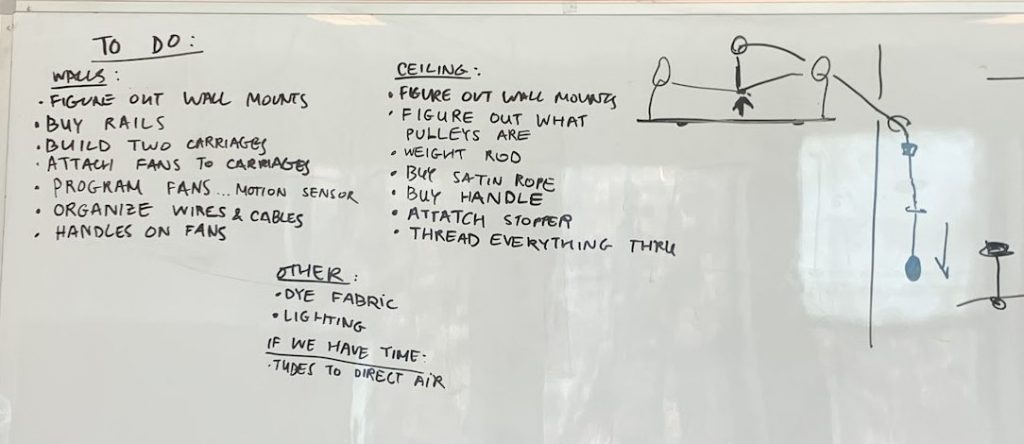Concept
Originally, I was inspired by the Tower of Babel and its connection between books, languages, and human knowledge. I wanted to build a intriguing installation amongst the book shelves that resembles the imaginary design of the tower, and hopefully invoke discussions about human’s desire to advance their understanding of the universe further, and the library’s role in this process.
Notable Successes
The final product is a beautiful “night lamp-like” form that is pleasing to look at. The aesthetic of the “tower” came out better than I expected, especially with the led light being diffused and shined through the semi-transparent fabric, and the warm led light I chose fit well with the atmosphere of the library.
To support the final spiral fabric shape, the internal structure, although might be overengineered, is an elegant construct that is the result of careful modeling and calculating in SolidWorks, and a sleepless night of assembling and gluing.

To my surprise, the final result is notably rigid, as it still stands intact in my apartment till this day (May 11th).
Even More Notable Failures
At first I was going to embroil the fabric with the original text from the Bible that describes the tower, but encrypted using Caesar’s cipher as a metaphor for the LORD confounding human language. However, after a small scale prototype of this idea, I realized that this would be too much work even with the automatic embroidery machine, as the fabric is 6 meters+ long. Ideally I would like this or some other form of decoration to hint more that this is referring to a classic tale, so that the audience can be guided a little when thinking about this piece.
Another thing I want to improve is the process. One of the most important lessons I learned from this class is that it is crucial for an artist to see what they want to make quickly, and iterate over that light weight prototype, instead of let the idea lives only in their head forever. I definitely did the latter in this case, by the time I realized that I need to change something to the design, I was already too committed to the “intricate” internal structure to change course.
]]>



A part of the project I was personally really proud of was making the net structural/able to take body weight. While body weight did not get incorporated into the final installation actuation methods it was good proof to myself that I have the experience and tools to create something this load-bearing.

This project came in the middle of tech for School of Drama so I was not able to give it the attention and care it perhaps deserved. That being said, I thought it turned out quite interesting and it was a fun process of exploration and juxtaposition for me.


The heavyweight materials on the bottom half contrasted quite dramatically with the top half that was kind of falling apart most of the time, which could be a metaphor for my mental state at the time. This project definitely needed a little more refinement but I was overall satisfied with the interactions (especially the 2-person actuation on the bottom knit net).
]]>When meeting with Olivia:


The following week attempting to make robust wire:
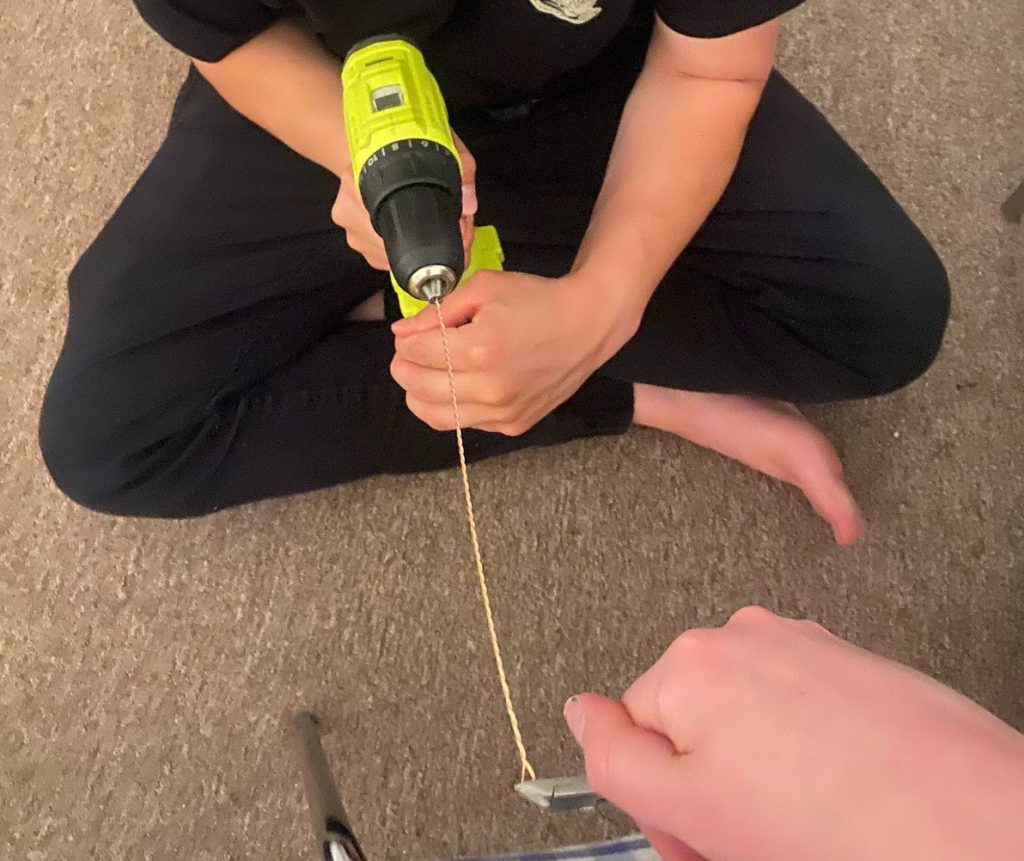
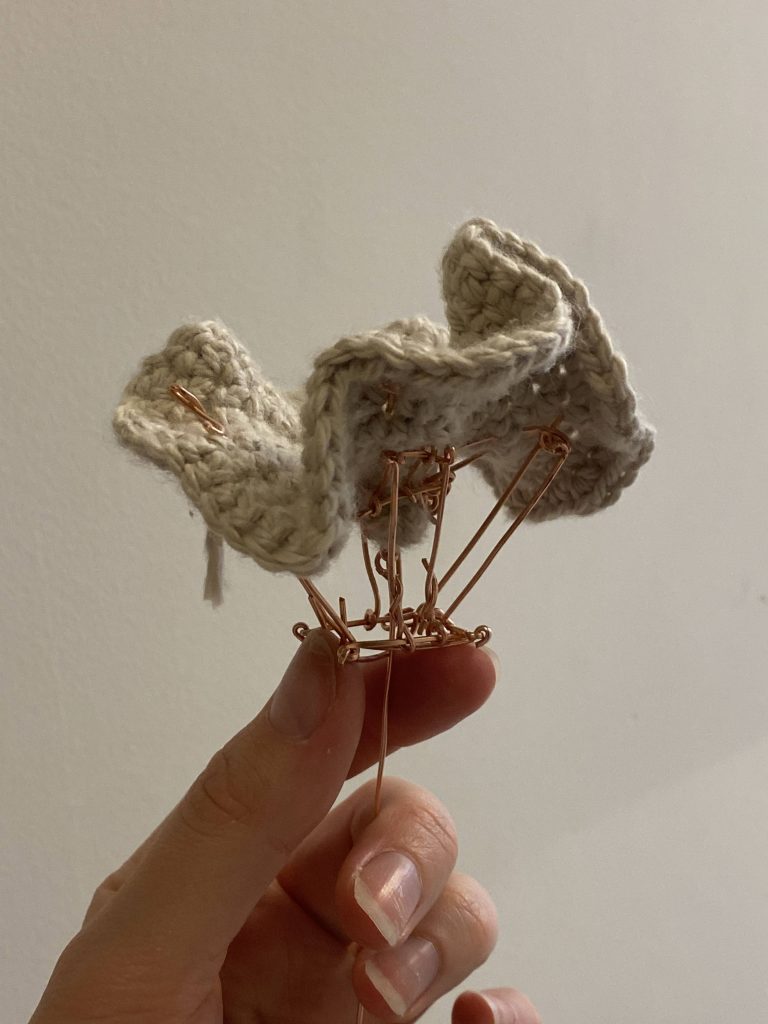

Studies of Yarn in Motion is a collection of three experiments activating yarn crocheted into hyperbolic surfaces. They can be found on a wall in the hallway between three intersections on your way to the photo booth, maker space, and study rooms. We wanted to inhabit a busy space with a lot of traffic that would invite IDeATe creatives to take a moment and play with some of the experiments while on their way. We wanted to share the motions we found captivating while playing with these textiles and create motion that could be experienced in under 5 minutes. The materials and textures were chosen to represent the kind of craft and explorations that can come from maker spaces. As Olivia pointed out, these studies really speak to the exploration and craft that happens at IDeATe. Another happy accident we found inhabiting this space were the woven pieces hanging opposite of the three studies. Having these pieces face one another really speaks to the breadth of soft textiles, one in motion and the other weaving a visual narrative.

In each of these studies we wanted to invite the participant to explore the motions we found captivating while playing with the crotchet yarn. We chose three movements and carefully crafted the moments to share by recreated mechanisms that would do what our hands could do: a show and tell without us to be there and show it. While these motions are controlled, we wanted the language of what they are made of, the process board, and the location within ideate to invite students to research and make their own if interested. Posted on the research board nearby are printed DIY slips and research papers that we mentioned. We found quite a lot of existing research on modeling hyperbolic forms through crochet, and a good amount of history attached to the use of craft (traditionally an undervalued ‘women’s’ skill) in modeling complex mathematics & biology. These three studies are a conclusion of what we found interesting, while also leaving room for more.



If we could use a metaphor for this process, it would look like rivers converging into a delta. The process was organic in the way that we explored many different avenues of how to bring the space and the crotchet pieces alive. Some of that exploration looked at how to activate the crotchet yarn at different scales, different locations, and through different activations. It was a process that allowed both of us to explore new things while bringing in skills we already had. It was a difficult to narrow down on an idea as there were so many possibilities through the crocheted yarn, however, once we decided to pursue creating motion studies we were able to make more headway. The process of making each study was about iteration. While we were really excited to work with wire and made many attempts to get it to create the motion we were looking for, it was not creating results quick enough as we did not have the skill and knowledge to make it into a final prototype. Those skills did not go unused, as they greatly influenced the laser cut parts and the end mechanisms. The largest learning from this is when deadlines are very short it may be best too work with skills one already has and later incorporate the new (i.e. wire mechanisms).

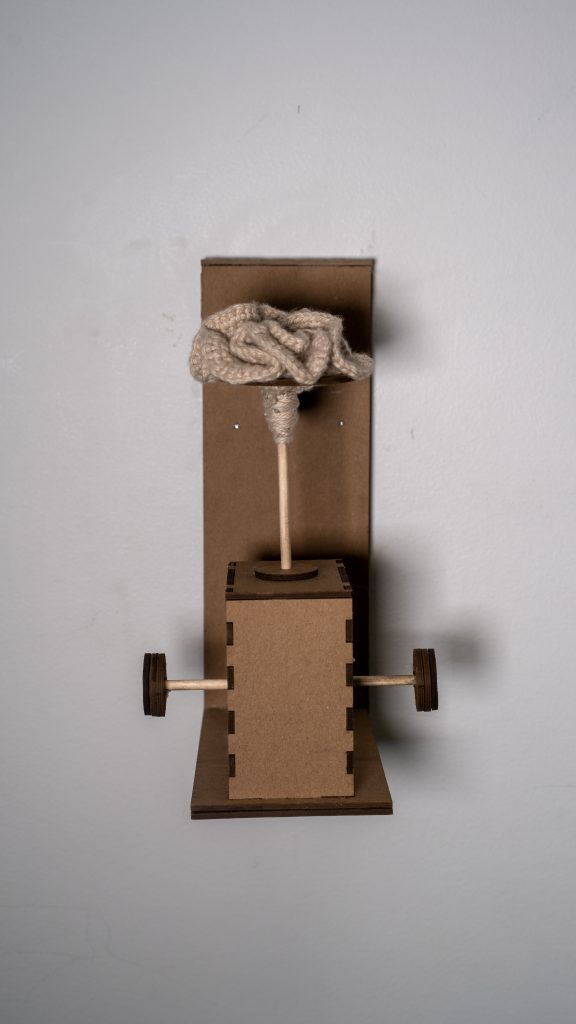

Overall, looking back at the pieces what could be enhanced is the motion of a few could have a wider range of motion. In addition, there could be another attempt to get people to touch it as the arrows we added did not help as much as we thought to get tactile experiences. What worked really well was having the collection of three studies each being a little different from the other, having the mechanics hidden, and the location. It was lovely to watch people be mesmerized with the movements just as we were. There were even a few people who thought the process board was a great way of understanding how these shapes were made.
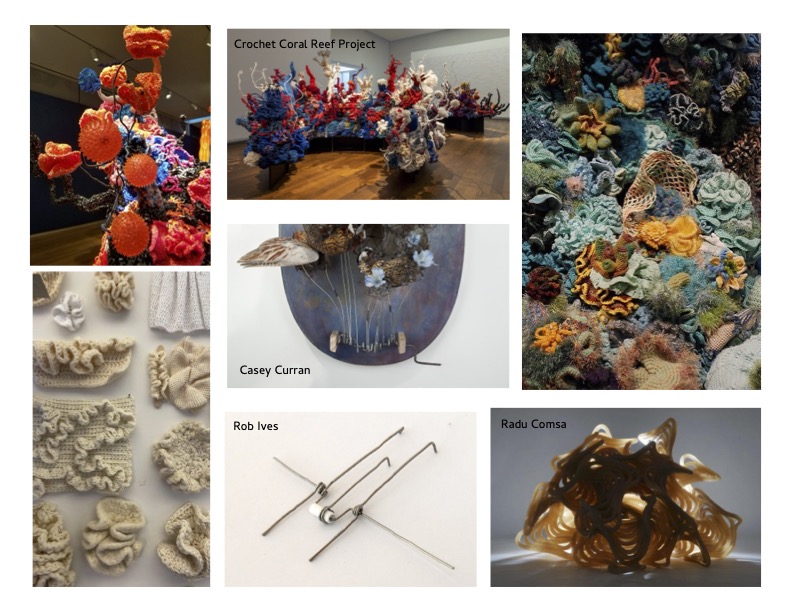

Final Concept:
The main idea behind our concept is to create a resting where people working in the Hunt basement can take a break. We aimed to create a visual and sensory experience that makes users feel like they are in their own bubble. The fabric and lighting elements were purposefully chosen to create an engaging experience so that people could forgot about real life for a bit.
Physical Prototype :
Our prototype had 3 main elements: the curtain, the backrest, and the mechanical system.
For the curtain we intended for it to be sensory stimulating on the inside while being bland on the outside. We wanted the inside experience to seem mysterious to people on the outside. We carried out this intention by creating a multi layered piece. The outside layer was a solid black fabric intended to hide everything on the inside. The middle layer was a solid white fabric intended to make sure the black fabric was not visible on the inside while also acting as a background for the inner most layer. In between the black and white fabrics we installed light fixtures in order to illuminate the inside experience (the white fabric helped diffuse the light). The inside layer consisted of a silk fabric dyed and bound using a shibori technique to create a field of indigo flowers and lime green leaves that popped out of the curtain.
For the backrest we intended to create a cushion that was comfortable to lean against and also something that looked like you could lean against it. We based our design off of a typical pillow. On the back of the cushion we attached a pressure sensor that was activated when someone leaned against the cushion.
For the mechanical system we intended to create a system that could lower and raise the curtain. We first created a wooden frame over which we would drape the curtain in order to provide structure to the way the curtain hung. We went with a “U” like shape. We attached a rod to the wall and attached the curtain to the rod via string. We attached the rod to motors that were programmed to rotate when the pressure sensor was activated or deactivated. When someone leaned against the cushion, the rod would rotate to unravel the string and the opposite would happen when there was no one leaning.
Successes and Failures:
Successes
- able to create a beautiful fabric pattern on the curtain using shibori
- able to create a layered curtain where the inside and outside contrast
- able to create a mechanical system that ravels and unravels the curtain
- able to trigger the motion of the curtain by the act of “leaning”
- able to create an enclosed experience that takes people away from the physical location
Failures
- weren’t able to hide the curtain very well in idle state
- weren’t able to hide the shibori fabric in idle state from the inside
- white fabric was visible from the outside
- system was louder than expected
Silk Ocean is a large-scale kinetic fabric installation meant to transform a viewer’s experience of the hallway it inhabits. Large pieces of silk billow gently around the viewer emulating the sea’s embrace as they walk through the hallway, instilling a sense of calmness. At the beginning of the hallway, the walls are dark. As you walk down the hallway, the colors become brighter, signaling a transformation of states. The walls of the hallway ripple in the wind created by fans once a person enters. They are blue like the ocean and extend above the viewer’s head for a feeling of immersion. The fabric piece on the ceiling is a slow gradient from purple to orange to mimic the changing colors of a sunset transforming the harsh hallway light into a softer enveloping experience. When a viewer pulls a handle at the front of the hallway, the ceiling begins to move in a gentle wave.
The piece is made up of 3 sheets of Bombyx Mori silk (~30 ft long) hanging from the ceiling with safety pins, shower curtain rings, and twine. It uses an ultrasonic sensor with Arduino to detect visitors and two 12v fans with one on a hinge to ripple the wall fabric.
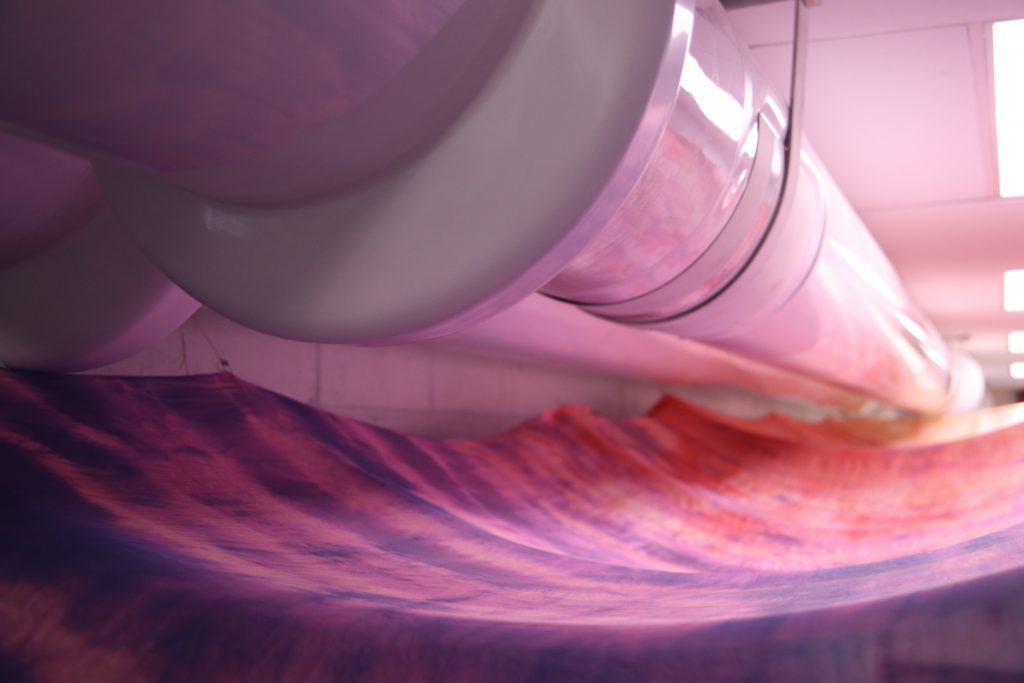


In the development of this project, we had some issues with figuring out how to create the motion we wanted on the walls. We started by considering creating a standing wave with appendages on motors connecting to the fabric to create a ripple. This was way too complicated, so we decided to go with fans. We wanted the fans to be interactive by putting them on rails that could slide up and down, but we found this motion did not create the desired effect. We decided on fans that turn on hinges to produce varying ripples upon interaction using the pocket between the walls to billow the fabric. It was also a journey to figure out what material would work best for the ceiling pulley system. We started with a satin cord because it seemed low friction enough, but it was sticking to the shower curtain rings too much. We ended up using fishing wire because it ran more smoothly, but it started cutting through our plastic rings. Finally, we decided to replace the shower curtain rings with counter-weighted metal eye bolts, and our problems were solved.

Our goal for this project was to inhabit the space to transform a cold, sterile hallway into a soft, gentle, and beautiful space of transition. We think the movement we achieved was successful in creating this effect, as well as the dye job. A future iteration of this project could be one without mechanical interaction. Although it was interesting to get the mechanical interactions to work, a Silk Ocean without these components might allow a viewer to engage with the textile more. We actually discovered this movement during installation and captured footage of viewers interacting more personally with the piece with paddle-type gloves:
Concept:
Pensieve is a mesmerizing and introspective kinetic art installation. It is a well of fabric delicately suspended in midair which holds fluid-like light. Upon peering into the Pensieve, one can observe how different colors imbue the fabric with unique life; Some hues are vibrant, evoking strong and visceral emotions and memories, while others are soft, casting a calming and contemplative aura. As the Pensieve contracts sharply, colors become bolder and fleeting ripples emerge across the fabric. When the Pensieve expands slowly, colors become more diffuse and envelop the observer’s field of vision. Overall, there are many unique ways for each observer to experience Penseive as a canvas for emotions and memories, drawn simply with vivid hues of light and a single mode of motion.
Physical Description:
The fabric is a 4’x4′ square of jersey suspended from an 8’x8′ ceiling area. We used an Arduino to program a neopixel ring light to change color in a gradient fashion over time. The wire used to suspend the fabric is reaction tackle. The string system used to move the fabric in a net-like fashion uses 4 constraint wires, 4 wires to pull each constraint one way (contract) (these wires are attached to a handle), and 4 wires to pull each constraint the other way (expand) (these wires are attached to a counterweight to help the fabric reset to its expanded position). The following is more media showing the piece from afar and the string mechanics:

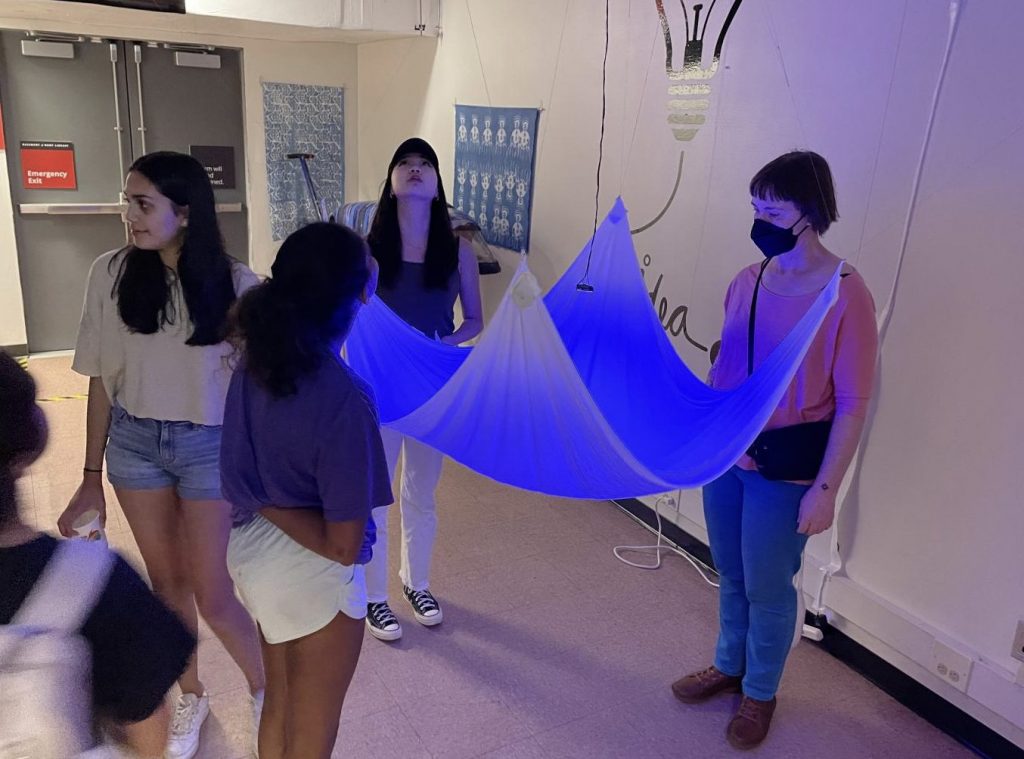
Successes and Failures:
We were very pleased with the lighting effect we achieved. At first, we were intending to install two ring lights with different colors to achieve a blending effect with the light, but we failed by breaking one of the lights accidentally. The single light source ended up being very beautiful and evocative though, which was a success.
Our mechanical system could have been refined more — in the final product the motion was constricted due to an error we made in the rigging, and there was generally still high friction. Many people were worried about pulling our piece too hard; unfortunately pulling with a lot of force was required because of the friction, which also reduced the durability of our piece. In the next iteration, we could experiment with using pulleys for smoother control.
We also struggled a bit with integrating into the space that we occupied. We preferred a dark environment to make the lighting stronger but unfortunately were situated near a fire exit. However, we argue that we succeeded in one of our original goals of creating a meditative environment amidst a busy work area. Occupying a space somewhat separated from the main lobby of the basement provides us with an inherently “sheltered” area where students can catch a break from studying and do some introspection instead.
Overall, from this project we learned about the ups and downs of the design and debugging process and how surprises in iterations over time can change our project direction. We also gained experience balancing feedback from viewers with our original visions for the piece.
Related Work:
Some artists/works that inspired this piece include:
James Turrell — Space that Sees

Mark Rothko — Untitled (Red)

I created a simple pulley system with a weighted rope and two dangling globs. The intended effect of the installation is to create a sense of imbalance between two people. The two people involved must work together to maintain balance or create motion.
The globs are made of stretchy fabric with ruffled seams constructed on the overlock machine. When the glob is in a stretched state, the seams extend to be nearly straight. When the stretchy fabric bounces back up, the seams ruffle.
This installation is simple, but is intended to be engaging. There may be some silly connections to the human body, but that’s not the overall purpose. I wanted this installation to be entrancingly playful.
Next, we will focus on the lighting since that is a major component of our piece!
]]>We are currently working out fabricating the carriage/rail system for the wall fans and the counter-weighted pulley system for the ceiling drop mechanism.
As the walls prove easier to hard mount to, we decided to move the pulley mount mechanism to the walls and keep the mechanism mechanical over electrical to simplify the system as well as not make an eyesore to detract from the Silk Ocean experience.
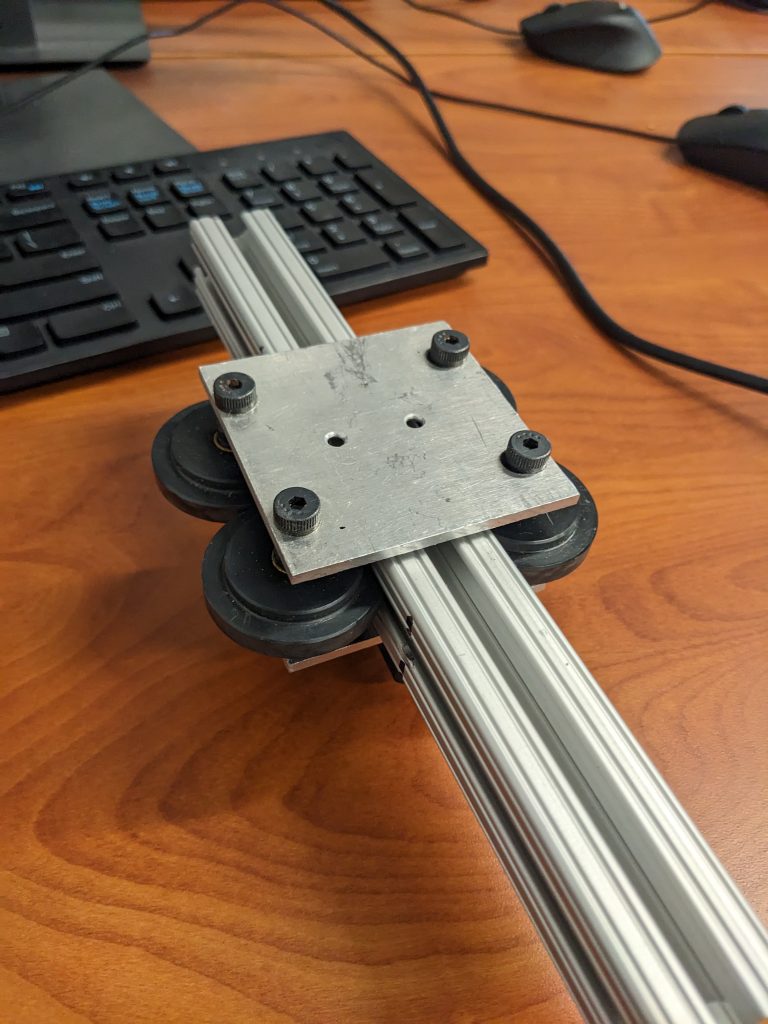
For the fans, the carriage will be built with aluminum sheets and 2 80/20 wheels hopefully enabling the carriage to friction fit and hold in place allowing users to move and keep the fans in place for when they walk through the hallway.
